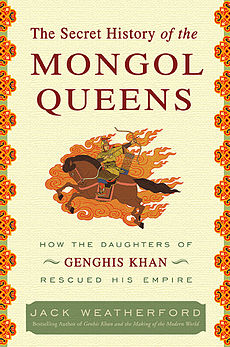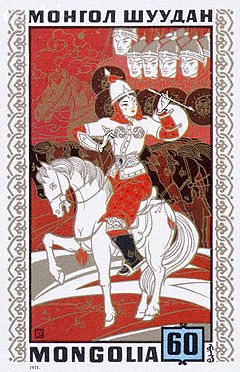- Mandukhai Khatun
-
Mandukhai Khatun (also known as Mandukhai Sechen Khatun or Queen Manduhai the Wise) (c. 1449 - c. 1510) was the Empress of the Post-imperial Mongolia. She united the warring Mongols with her husband Batmunkh Dayan Khan.
Contents
Background
Mandukhai was the only daughter of Chorosbai chingsang (grand councillor) of the Ongud Mongols in eastern Mongolia. Her family were aristocrats. At the age of 18, Mandukhai was married to Manduul Khan (who ruled the Mongol Empire from 1473–1479), to whom she bore a daughter and was preferred over Yekhe Khabartu Yungin, his childless first queen.
After the death Manduul Khan in 1467 at the hands of his own advisor Eslem (who he didn`t know was a spy from Ming China), the throne was left without an heir. Mandukhai brought back and adopted the 7 year old orphan Batmunkh, son of Bayan Monke Jonon (very high rank usually given to the brother of the king), a direct descendant (from the Golden Horde) of Genghis Khan, who had been killed by Eslem. Batu Monke was the last living descendant of Genghis Khan, and Mandukhai had him proclaimed Dayan Khan, rejecting marriage to General Unubold. However, Unebold, a descendant of Hasar, younger brother of Genghis Khan, remained loyal to Mandukhai and her child Khan.
Empress of Mongolia
Thus Mandukhai took command over the Mongols and warred with the Oirats, and gloriously defeated them. After oppressing the Western Mongols who consistently waged civil wars, Mandukhai and Dayan Khan punished them by demanding that they follow five codes.
The codes included:
- Crests of helmets must not exceed two fingers long
- Eat meat without a knife
- Do not call your Ger (Yurt) an Ordon (Palace)
- Do not call airag but tsegee
- Sit upon your knees before khans
The Oirats accepted everything except for the second one. Her stunning victory over the Oirats brought back great reputation of the Chinggisids.
When Batmonkh turned nineteen, she married him and retained her control over the Mongols. The Oirats again rebelled and raided the Eastern Mongols. Mandukhai lead the great army against them. She was pregnant, but still fought and delivered twin boys during a long battle. Western Mongols were put down again.
From 1480 Dayan Khan and Mandukhai were pressured by the Ming Chinese territory because they closed the border trade and killed a Mongol envoy. To contain her, the Ming Chinese rapidly expanded the Great Wall and now used the new artillery of gunpowder to defeat her troops. Mandukhai married Dayan Khan but continued to rule Mongolia.[1] She reoccupied Ordos area and stationed soldiers there to keep watch on China. While Dayan Khaan was battling Ming army, Eslem Ming spy who had been a close king`s advisor for the past thirty years who lead much trouble attacked the fortress of the king trying to kill Mandukhai and the heir to the throne. Eslem was allowed in with no suspicion and opened the gates, Mandukhai and the outnumbered guards fought valiantly but were overwhelmed by surprise. The heir to the throne Ulasbold was secretely taken to safety, but Mandukhai died fighting Eslem in 1510.
Legacy
 Mandukhai in The Secret History of the Mongol Queens by Jack Weatherford.
Mandukhai in The Secret History of the Mongol Queens by Jack Weatherford.
Mandukhai managed to keep Dayan Khan in power as a Chingis Khan's descendant and defeated the Oirats, actions which have contributed to the legends which formed about her life.
She left seven sons and three daughters. The later khans and nobles of Mongolia are her descendants.
Mandukhai the Wise (Мандуухай сэцэн хатан) is a Mongolian film based on a novel of the same title by Ts. Natsagdorj; both are a recounting of her life.
References
- Davis-Kimball, Jeannine.(2002) Warrior Women, An archealogist's Search for History's Hidden Heroines. Warner Books, Inc. Page 226-228. ISBN 0-446-52546-4
- Jack Weatherford - The Secret History of the Mongol Queens: How the Daughters of Genghis Khan Rescued His Empireь Crown 2010
- ^ Sarah M. Nelson-Ancient queens, p.167
Categories:- People of the Mongol Empire
- Mongol khans
- Female regents
- Women in Medieval warfare
- Women in war in Asia
Wikimedia Foundation. 2010.

